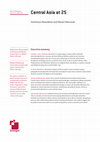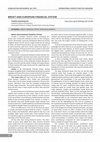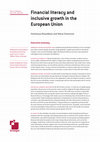Papers by Uuriintuya Batsaikhan

Positive Money is an international research and campaign organisation working to redesign our eco... more Positive Money is an international research and campaign organisation working to redesign our economic system for social justice and a liveable planet. Set up in the aftermath of the financial crisis, Positive Money is a not-for-profit company funded by charitable trusts and foundations, as well as small donations from its network of supporters. Positive Money Europe has an office in Brussels and is a registered interest group in the EU's lobbying transparency register (entry number 224435319949-22). www.positivemoney.eu WWF is one of the world's most respected and experienced conservation organizations, with over five million supporters and a global network active in more than 100 countries. WWF's mission is to stop the degradation of the planet's natural environment and to build a future in which people live in harmony with nature. WWF has worked with the finance sector for more than a decade via innovative collaborations that seek to integrate ESG risks and opportunities into mainstream finance, to redirect financial flows in support of the global sustainable development agenda. Through its Greening Financial Regulation Initiative (GFRI), WWF engages specifically with central banks and financial regulators and supervisors on the need to fully integrate climate and environmental risks into mandates and operations. For more information, visit panda.org/gfr or contact us at

Policy Contributions, May 1, 2017
Central Asia, though referred to as a single region, consists of five culturally and ethnically d... more Central Asia, though referred to as a single region, consists of five culturally and ethnically diverse countries that have followed different political and economic transformation paths in the last 25 years since independence from the Soviet Union. Kazakhstan and Kyrgyzstan have in relative terms made strides in market reforms, while Turkmenistan and Uzbekistan still have not completed their transitions to a market economy and Tajikistan represents an intermediate case. In many respects, the historical legacy of the twentieth century and their unique geographical and geopolitical location have not helped Central Asian countries in their efforts towards economic development and integration. After experiencing more than a decade of growth based on hydrocarbon booms, Central Asian countries are faced with increasing challenges resulting from falling commodity prices, declining trade and lower migrant remittances. The main policy challenge is to move away from commodity-based growth strategies to macro-oriented diversification and adoption of a broad spectrum of economic, institutional and political reforms. However, structural diversification is easier said than done. The major obstacles to political reform and economic diversification in the five Central Asian economies are internal and external geopolitical factors and deeply embedded institutional weaknesses within countries, particularly in areas where economic management interacts with authoritarian political systems and legal institutions. Our analysis suggests five key policy lessons that could serve as points of departure as these countries move ahead.
textabstractBrexit will lead to a partial migration of financial firms from London to the EU27. T... more textabstractBrexit will lead to a partial migration of financial firms from London to the EU27. This Policy Contribution provides a comparison between London and four major cities that will host most of the new EU27 wholesale market: Frankfurt, Paris, Dublin and Amsterdam. It gives a detailed picture of the wholesale markets, the largest players in these markets and the underlying clearing infrastructure. It also provides data on professional services and innovation.

Positive Money Europe is a not-for-profit research and campaigning organisation whose mission is ... more Positive Money Europe is a not-for-profit research and campaigning organisation whose mission is to build a diverse and powerful movement pushing for a progressive reform agenda of the European Central Bank and Eurozone institutions so they support a fair, democratic and sustainable economy. Positive Money Europe was set up by Positive Money, a UK nonprofit founded in 2010. Positive Money Europe has an office in Brussels and is a registered interest group in the EU's lobbying transparency register (entry number 224435319949-22). WWF is an independent conservation organization, with over 35 million followers and a global network active through local leadership in over 100 countries. Our mission is to stop the degradation of the planet's natural environment and to build a future in which people live in harmony with nature, by conserving the world's biological diversity, ensuring that the use of renewable natural resources is sustainable, and promoting the reduction of pollution and wasteful consumption. Find out more at panda.org. Find out more about WWF's Greening Financial Regulation Initiative: panda.org/gfr
Introduction 17 2. Public perception 23 3. Mapping migration in the European Union 3.1 Annual imm... more Introduction 17 2. Public perception 23 3. Mapping migration in the European Union 3.1 Annual immigration and emigration trends 3.2 Intra-EU mobility 3.3 Immigration from outside the EU 3.4 The share of foreign citizens and foreign-born people resident in the population 4 The economic impact of immigration 4.1 Impact on output 4.2 Labour market impact 4.3 Fiscal impact 4.4 Impact of the sudden flow of migrants 5 Integration of migrants 5.1 Labour market 5.2 Education 5.3 Income and poverty 5.4 Active citizenship 5.5 Migration integration index 6 Financial inclusion of refugees 6.1 Barriers and initiatives 6.2 Bruegel survey of financial institutions 7 Policy implications for the EU 7.1 Measures taken to manage the refugee crisis 7.2 Intra-EU mobility and posted workers 7.3 Policy recommendations

Globalization and Business, 2017
London is Europe’s financial centre, providing corporate and investment banking services to the E... more London is Europe’s financial centre, providing corporate and investment banking services to the European Union’s 28 member countries and beyond. When the United Kingdom leaves the EU and its single market by the spring of 2019, UK-based financial firms will lose their passport to do direct business with EU27 clients. Brexit thus leads to a partial migration of financial firms from London to the EU27 (EU minus the UK) so that they could continue to serve their customers there. We provide a comparison between london and four major cities that together will host most of the new EU27 wholesale market: Frankfurt, Paris, Dublin and Amsterdam.We also give a detailed picture of the wholesale markets(foreign exchange, securities and derivatives trading), the largest players in these markets (the major banks) and the underlying clearing infrastructure. London is an international financial centre, serving European and global clients. A hard brexit would lead to a partial migration of financial...

Central Asia at 25. Bruegel Policy Contribution Issue n˚13 | May 2017
Central Asia, though referred to as a single region, consists of five culturally and ethnically d... more Central Asia, though referred to as a single region, consists of five culturally and ethnically diverse countries that have followed different political and economic transformation paths in the last 25 years since independence from the Soviet Union. Kazakhstan and Kyrgyzstan have in relative terms made strides in market reforms, while Turkmenistan and Uzbekistan still have not completed their transitions to a market economy and Tajikistan represents an intermediate case. In many respects, the historical legacy of the twentieth century and their unique geographical and geopolitical location have not helped Central Asian countries in their efforts towards economic development and integration. After experiencing more than a decade of growth based on hydrocarbon booms, Central Asian countries are faced with increasing challenges resulting from falling commodity prices, declining trade and lower migrant remittances. The main policy challenge is to move away from commodity-based growth st...
Europe needs to know how it can realise the potential for industrial rejuvenation. How well are E... more Europe needs to know how it can realise the potential for industrial rejuvenation. How well are European firms responding to the new opportunities for growth, and in which global value chains are they developing these new activities? The policy discussion on the future of manufacturing requires an understanding of the changing role of manufacturing in Europe’s growth agenda.
Policy Contributions, 2017
Central Asia, though referred to as a single region, consists of five culturally and ethnically d... more Central Asia, though referred to as a single region, consists of five culturally and ethnically diverse countries that have followed different political and economic transformation paths in the last 25 years since independence from the Soviet Union. After experiencing more than a decade of growth based on hydrocarbon booms, these countries are faced with increasing challenges resulting from falling commodity prices, declining trade and lower migrant remittances. The main policy challenge...

Policy Contributions, 2018
Growing financialization and complexity demands financial literacy to be an integral part of the ... more Growing financialization and complexity demands financial literacy to be an integral part of the research agenda and policy design globally. It applies particularly to developed countries, since research findings suggest that financial literacy becomes more important with higher levels of economic development. Financial literacy is financial education, such as basic economics, statistics and numeracy skills combined with the ability to employ these skills in making financial decisions. Research has shown that as people become more financially literate, they make better saving and borrowing decisions, are more likely to plan for retirement and hold more diverse assets in their balance sheet. As more and more households are asked to make their own decisions about such issues, financial illiteracy can become a serious threat to their life-time welfare. The European Union contains in itself the world’s best performers (Sweden, Denmark) as well as those that score below global average (R...
Migration is one of the most divisive policy topics in today’s Europe. In this publication, the a... more Migration is one of the most divisive policy topics in today’s Europe. In this publication, the authors assess the immigration challenge that the EU faces, analyse public perceptions, map migration patterns in the EU and review the literature on the economic impact of immigration to reflect on immigration policies and the role of private institutions in fostering integration.
Financial literacy is financial education, such as basic economics, statistics and numeracy skill... more Financial literacy is financial education, such as basic economics, statistics and numeracy skills combined with the ability to employ these skills in making financial decisions. As more and more households are asked to make their own decisions about such issues, financial illiteracy can become a serious threat to their life-time welfare. The authors of this paper explain why financial literacy matters and suggest, in light of their findings, some policy recommendations.

Cryptoeconomics – the opportunities and challenges of blockchain
What is blockchain? The Economist explains that in order to understand how blockchain works, firs... more What is blockchain? The Economist explains that in order to understand how blockchain works, first we need to distinguish between three things - the bitcoin, the cryptocurrency, the specific blockchain underlying it and blockchains in general. Bitcoin is the largest, most known project that uses this technology, but numerous other large cryptocurrencies are emerging based on blockchain. Blockchain is a trusted public ledger without single user control or centralized authority, where the participants themselves collectively keep track of the system. Bitcoin’s blockchain, for instance, keeps track of the transactions continuously and prevents double-spending. Source - The Economist. Christian Catalini explains on the MIT blog that blockchain, like the internet in its early years, is hard to understand and predict. In a blockchain, transactions are recorded chronologically and form a “block” which can be data of many types- currency, digital rights, identity, property titles to name a ...
Introduction 17 2. Public perception 23 3. Mapping migration in the European Union 3.1 Annual imm... more Introduction 17 2. Public perception 23 3. Mapping migration in the European Union 3.1 Annual immigration and emigration trends 3.2 Intra-EU mobility 3.3 Immigration from outside the EU 3.4 The share of foreign citizens and foreign-born people resident in the population 4 The economic impact of immigration 4.1 Impact on output 4.2 Labour market impact 4.3 Fiscal impact 4.4 Impact of the sudden flow of migrants 5 Integration of migrants 5.1 Labour market 5.2 Education 5.3 Income and poverty 5.4 Active citizenship 5.5 Migration integration index 6 Financial inclusion of refugees 6.1 Barriers and initiatives 6.2 Bruegel survey of financial institutions 7 Policy implications for the EU 7.1 Measures taken to manage the refugee crisis 7.2 Intra-EU mobility and posted workers 7.3 Policy recommendations

Russian Journal of Economics
Central Asia consists of five culturally and ethnically diverse countries that have followed diff... more Central Asia consists of five culturally and ethnically diverse countries that have followed different paths to political and economic transformation in the past 25 years since achieving independence from the Soviet Union. Kazakhstan and Kyrgyzstan have in relative terms made strides in market reforms, while Turkmenistan and Uzbekistan have not yet completed their transitions to market economies. Tajikistan represents an intermediate case. After experiencing more than a decade of growth based on hydrocarbon booms, Central Asian countries are faced with increasing challenges resulting from falling commodity prices, declining trade and lower migrant remittances. The main policy challenge is to move away from commodity-based growth strategies to market-oriented diversification and adoption of a broad spectrum of economic, institutional and political reforms. The major obstacles to political reform and structural diversification in the five Central Asian economies are internal and external geopolitical factors and deeply embedded institutional weaknesses within each country, particularly in areas where economic management interacts with authoritarian political systems and imperfect legal institutions.

Reconciling contradictory forces: financial inclusion of refugees and know-your-customer regulations
Journal of Banking Regulation
Providing access to financial services for asylum seekers and refugees is made difficult by know-... more Providing access to financial services for asylum seekers and refugees is made difficult by know-your-customer financial regulations adopted as part of efforts to tackle money laundering and terrorist financing activities. Difficulties in identifying asylum seekers and refugees further complicate the urgent necessity of opening simple bank accounts, which is a crucial step towards integration. We review certain financial inclusion initiatives and assess European Union banking regulations from the perspective of offering financial services to asylum seekers and refugees. We conduct a novel survey of banks in the European Union to shed light on banks’ attitudes to the financial integration of refugees, their assessment of the relevant banking regulations and possible public–private partnerships to improve the financial integration process. We conclude that the solution to the financial inclusion problem is not to ease regulation, but to tailor it to the specific needs of refugees, while offering clear guidelines to banks and improving refugee identification. We make several recommendations, including the issuance of a European identification document to each refugee and the development of a pan-European registry of refugees.

Russian Journal of Economics, 2017
Central Asia consists of five culturally and ethnically diverse countries that have followed diff... more Central Asia consists of five culturally and ethnically diverse countries that have followed different paths to political and economic transformation in the past 25 years since achieving independence from the Soviet Union. Kazakhstan and Kyrgyzstan have in relative terms made strides in market reforms, while Turkmenistan and Uzbekistan have not yet completed their transitions to market economies. Tajikistan represents an intermediate case. After experiencing more than a decade of growth based on hydrocarbon booms, Central Asian countries are faced with increasing challenges resulting from falling commodity prices, declining trade and lower migrant remittances. The main policy challenge is to move away from commodity-based growth strategies to market-oriented diversification and adoption of a broad spectrum of economic, institutional and political reforms. The major obstacles to political reform and structural diversification in the five Central Asian economies are internal and external geopolitical factors and deeply embedded institutional weaknesses within each country, particularly in areas where economic management interacts with authoritarian political systems and imperfect legal institutions.

Reconciling contradictory forces: financial inclusion of refugees and know-your-customer regulations
Journal of Banking Regulation, 2019
Providing access to financial services for asylum seekers and refugees is made difficult by know-... more Providing access to financial services for asylum seekers and refugees is made difficult by know-your-customer financial regulations adopted as part of efforts to tackle money laundering and terrorist financing activities. Difficulties in identifying asylum seekers and refugees further complicate the urgent necessity of opening simple bank accounts, which is a crucial step towards integration. We review certain financial inclusion initiatives and assess European Union banking regulations from the perspective of offering financial services to asylum seekers and refugees. We conduct a novel survey of banks in the European Union to shed light on banks’ attitudes to the financial integration of refugees, their assessment of the relevant banking regulations and possible public–private partnerships to improve the financial integration process. We conclude that the solution to the financial inclusion problem is not to ease regulation, but to tailor it to the specific needs of refugees, while offering clear guidelines to banks and improving refugee identification. We make several recommendations, including the issuance of a European identification document to each refugee and the development of a pan-European registry of refugees.








Uploads
Papers by Uuriintuya Batsaikhan